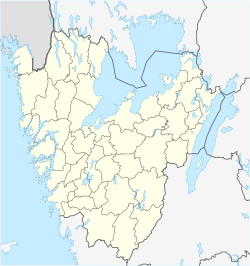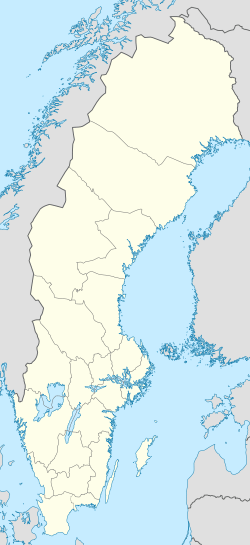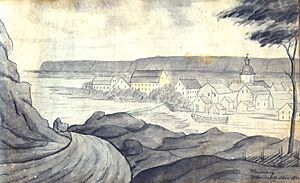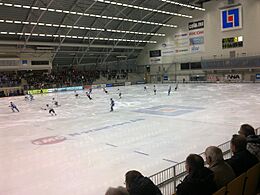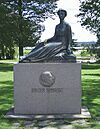Vänersborg facts for kids
Quick facts for kids
Vänersborg
|
|
|---|---|

Vänersborg in July 2006
|
|
| Country | Sweden |
| Province | Västergötland |
| County | Västra Götaland County |
| Municipality | Vänersborg Municipality |
| Area | |
| • Total | 11.57 km2 (4.47 sq mi) |
| Population
(2018)
|
|
| • Total | 23,882 |
| • Density | 2,048/km2 (5,300/sq mi) |
| Time zone | UTC+1 (CET) |
| • Summer (DST) | UTC+2 (CEST) |
Vänersborg is a town in Sweden. It is the main town of Vänersborg Municipality in Västra Götaland County. About 23,882 people live here.
Until 1997, Vänersborg was the capital of Älvsborg County. This county was closed down in 1998. Since 1999, Vänersborg has been the main place for the regional government of Västra Götaland County. The town is located on the southern shore of Vänern, which is a large lake. It is also near where the Göta älv river flows out of the lake.
Contents
History of Vänersborg
A long time ago, around the end of the Middle Ages, there was a market town called Brätte. It was located south of where Vänersborg is today. This town had paved streets and many houses. It even got special rights to be a town in 1580.
However, the harbor at Brätte started to fill up with dirt and sand. This made it hard for ships to use. It was also difficult to protect the town from attacks. So, in 1644, the town was moved about 3.5 kilometers north. The new town was named Vänersborg. People living in Brätte were not happy about moving, but they had to.
The name "Vänersborg" means "fortress at Vänern." It comes from a small fort built in 1644 to protect the new town. The town's coat of arms also dates from 1644. It shows a golden ship called a bojort with two Swedish flags.
Around the year 1800, Vänersborg had about 1,500 people. It was an important place for moving goods. Ships from the lake would unload their cargo here. Then, the goods would be carried around the Trollhättan Falls. After that, they could be loaded onto other ships to continue to Gothenburg and beyond.
In 1778, the King Karl Canal opened. This canal made it easier to move goods between Vänersborg and Trollhättan. In 1800, the new Trollhätte Canal with its locks allowed ships to travel directly between Lake Vänern and the sea. This waterway helped Vänersborg become even more important.
In 1834, a big fire burned down most of the town's wooden houses. After the fire, Vänersborg was rebuilt with a special grid pattern for its streets. This design is still unique today.
The Torpaskolan (a secondary school) first opened in 1965. It was replaced by the Nya Torpaskolan in 2011. The Arena Vänersborg, a large indoor sports arena, opened in 2009.
Climate
Vänersborg has a cold oceanic climate. This means it has mild winters and cool summers. It also gets a good amount of rain compared to other parts of Sweden. Between 1961 and 1990, it received about 709 millimeters (28 inches) of rain each year. In the early 2000s, the amount of rain increased even more.
The weather in Vänersborg is affected by its closeness to the Kattegat sea and Lake Vänern. This makes the differences between summer and winter smaller than in many other inland areas of Sweden. However, it still feels a bit like a continental climate. Being near the sea and a large lake means it often has rain and wind. In winter, it can even get lake-effect snow.
| Climate data for Vänersborg 2002–2018; extremes since 1901 | |||||||||||||
|---|---|---|---|---|---|---|---|---|---|---|---|---|---|
| Month | Jan | Feb | Mar | Apr | May | Jun | Jul | Aug | Sep | Oct | Nov | Dec | Year |
| Record high °C (°F) | 10.5 (50.9) |
14.9 (58.8) |
21.0 (69.8) |
26.6 (79.9) |
28.7 (83.7) |
32.0 (89.6) |
33.1 (91.6) |
33.0 (91.4) |
26.7 (80.1) |
21.3 (70.3) |
16.4 (61.5) |
11.7 (53.1) |
33.1 (91.6) |
| Mean maximum °C (°F) | 7.5 (45.5) |
7.5 (45.5) |
12.6 (54.7) |
19.1 (66.4) |
24.3 (75.7) |
26.2 (79.2) |
28.3 (82.9) |
26.8 (80.2) |
23.1 (73.6) |
16.9 (62.4) |
11.8 (53.2) |
8.5 (47.3) |
29.4 (84.9) |
| Mean daily maximum °C (°F) | 1.4 (34.5) |
1.7 (35.1) |
5.5 (41.9) |
11.4 (52.5) |
16.4 (61.5) |
19.7 (67.5) |
22.1 (71.8) |
20.8 (69.4) |
17.1 (62.8) |
11.1 (52.0) |
6.2 (43.2) |
3.1 (37.6) |
11.4 (52.5) |
| Daily mean °C (°F) | −1.2 (29.8) |
−1.1 (30.0) |
1.5 (34.7) |
6.3 (43.3) |
11.2 (52.2) |
14.5 (58.1) |
17.1 (62.8) |
16.2 (61.2) |
12.8 (55.0) |
7.5 (45.5) |
3.6 (38.5) |
0.5 (32.9) |
7.4 (45.3) |
| Mean daily minimum °C (°F) | −3.8 (25.2) |
−3.9 (25.0) |
−2.5 (27.5) |
1.2 (34.2) |
5.9 (42.6) |
9.3 (48.7) |
12.1 (53.8) |
11.6 (52.9) |
8.4 (47.1) |
3.9 (39.0) |
1.0 (33.8) |
−2.1 (28.2) |
3.4 (38.2) |
| Mean minimum °C (°F) | −15.2 (4.6) |
−13.4 (7.9) |
−11.1 (12.0) |
−5.3 (22.5) |
−1.4 (29.5) |
3.7 (38.7) |
6.9 (44.4) |
5.1 (41.2) |
0.4 (32.7) |
−3.9 (25.0) |
−7.3 (18.9) |
−11.9 (10.6) |
−18.2 (−0.8) |
| Record low °C (°F) | −28.0 (−18.4) |
−32.5 (−26.5) |
−26.9 (−16.4) |
−19.0 (−2.2) |
−3.5 (25.7) |
0.2 (32.4) |
2.9 (37.2) |
1.1 (34.0) |
−4.0 (24.8) |
−11.9 (10.6) |
−16.8 (1.8) |
−25.5 (−13.9) |
−32.5 (−26.5) |
| Average precipitation mm (inches) | 66.0 (2.60) |
46.7 (1.84) |
39.7 (1.56) |
44.9 (1.77) |
53.2 (2.09) |
81.5 (3.21) |
81.2 (3.20) |
94.4 (3.72) |
68.2 (2.69) |
85.6 (3.37) |
86.1 (3.39) |
85.4 (3.36) |
832.9 (32.8) |
| Source 1: SMHI Open Data | |||||||||||||
| Source 2: SMHI Monthly Data 2002–2018 | |||||||||||||
Economy
Vänersborg has grown thanks to its history of crafts, trade, and shipping. It was also important because it used to be the main town for Älvsborgs County. For hundreds of years, the town had a mix of people. These included government workers, business owners, artists, and skilled workers.
Today, the town is known for modern companies. These include high-tech engineering, IT, and electronics. Education and skilled services are also very important. Government jobs still play a big role in the town's economy.
Education
Vänersborg has many schools for students. Some of these include Torpaskolan, Tärnanskolan, and Vänerskolan. For older students, there are high schools like Birger Sjöberg High School and Frida High School. There is also an independent school called Fridaskolan.
Sports
The local bandy club, IFK Vänersborg, plays in the top league called Elitserien. Another club, Blåsuts BK, usually plays in the second-tier league, Allsvenskan.
Arena Vänersborg is a special indoor arena built for bandy. This arena caused some discussion because its final cost was much higher than planned. It ended up costing about 300 million Swedish Kronor.
Vänersborg was the host city for the 2013 Bandy World Championship for men's teams. It will host the championship again in 2019.
Districts
Vänersborg is made up of several smaller areas or districts. Some of these include Onsjö, Mariedal, Blåsut, Vargön, Lilleskog, Korseberg, Torpa, Nordstan, Restad, and Öxnered.
Notable People from Vänersborg
- Count Lennart Torstensson (1603–1651) was born near Vänersborg. He was a famous Swedish military leader and engineer.
- The poet Birger Sjöberg (1885–1929) was born in Vänersborg. He wrote fondly about the town, calling it "little Paris" in his book Fridas bok (1922). There is a statue of him in Skräckleparken, a park with a nice view of Lake Vänern.
- The well-known Swedish explorer and trader Axel Wilhelm Eriksson (1846–1901) was also born here. The local museum has a collection of birds from Africa that he gathered.
- The band Junip, which includes José González, partly comes from and started in Vänersborg.
- Swedish singer Agnes Carlsson was born in Vänersborg.
- The punk rock band Division of Laura Lee is from Vänersborg.
- Grammy-winning Hip Hop producer Tommy Black was born in Vänersborg.
See also
 In Spanish: Vänersborg para niños
In Spanish: Vänersborg para niños


